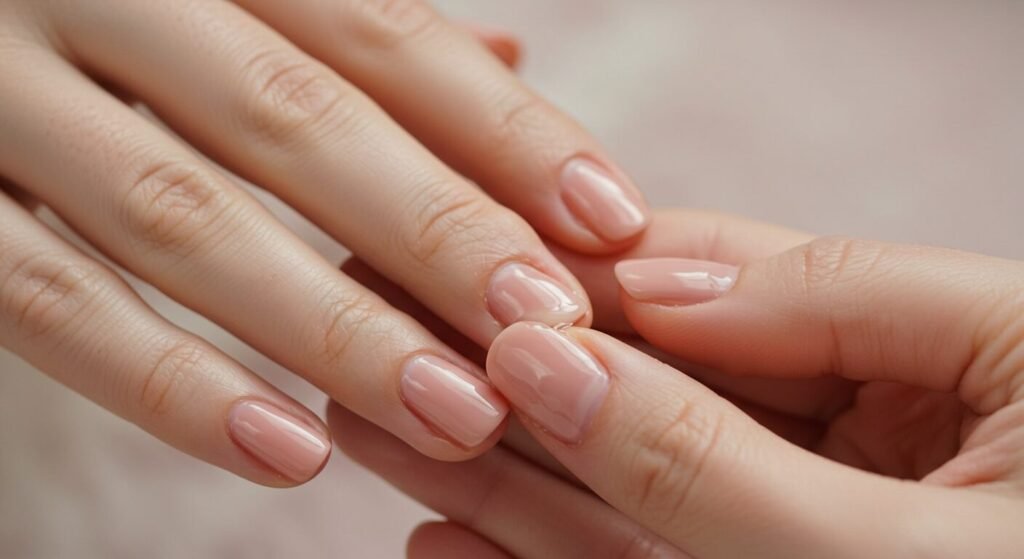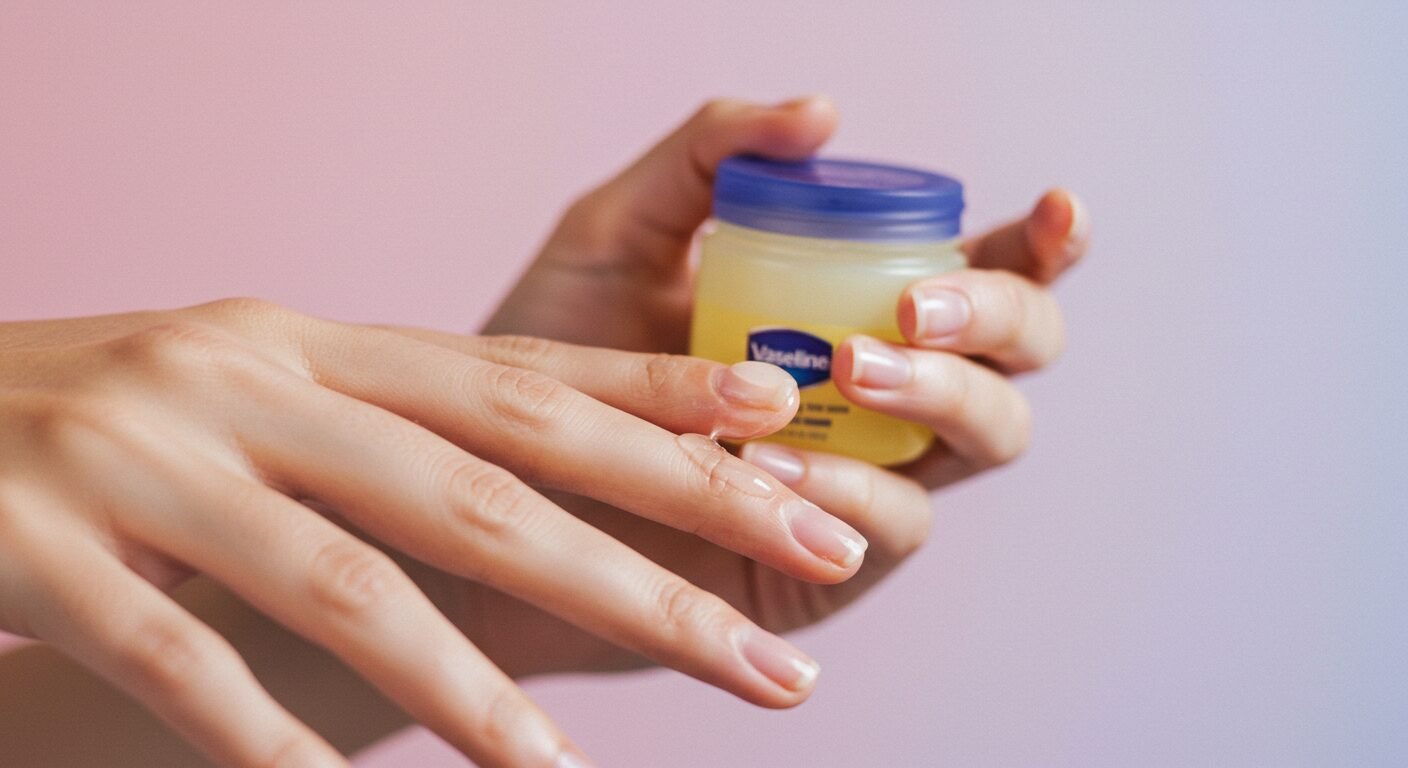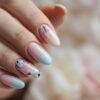Have you ever wondered if that trusty jar of Vaseline sitting in your medicine cabinet could be the secret to healthier, stronger fingernails? You’re not alone in this curiosity! Vaseline for fingernails has become a popular topic among beauty enthusiasts and nail care experts who are discovering the surprising benefits of this simple petroleum-based product.
Petroleum jelly for nail care might seem unconventional, but this affordable household staple has been quietly revolutionizing nail health routines worldwide. From strengthening brittle nails to protecting cuticles, Vaseline offers multiple benefits that could transform your nail care regimen without breaking the bank.
Let’s dive deep into the science, benefits, and practical applications of using Vaseline on nails to help you decide if this simple solution deserves a permanent spot in your beauty routine.
Understanding Vaseline and Its Composition
What Exactly Is Vaseline?
Vaseline composition consists primarily of petroleum jelly, a semi-solid mixture of hydrocarbons derived from petroleum. This petroleum jelly ingredients list is surprisingly simple – it’s essentially purified petroleum that’s been processed to remove impurities and create a stable, safe product for topical use.
Pure petroleum jelly like Vaseline creates an occlusive barrier on skin and nails, preventing moisture loss while protecting against environmental damage. This moisturizing properties make it particularly effective for areas that tend to dry out quickly, like fingernails and cuticles.
The molecular structure of petroleum jelly allows it to form a protective seal without clogging pores or interfering with natural skin functions. This unique characteristic makes Vaseline benefits particularly relevant for nail care applications.
How Vaseline Interacts with Nails
Nail structure consists of keratin proteins that can become dry and brittle without proper moisture balance. Vaseline nail treatment works by creating a protective barrier that locks in existing moisture while preventing further dehydration.
Cuticle care with Vaseline proves especially effective because the delicate skin around nails requires consistent hydration to remain healthy and flexible. Nail bed protection through petroleum jelly application helps maintain optimal conditions for healthy nail growth.
Absorption rates of Vaseline differ from lighter oils – while it doesn’t penetrate deeply into nail plates, it provides long-lasting surface protection that supports overall nail health and appearance.
Scientific Benefits of Vaseline for Nail Health
Moisture Retention and Hydration
Nail hydration represents one of the most significant benefits of using Vaseline for dry nails. The occlusive properties create a moisture barrier that prevents water loss from nail plates and surrounding skin tissue.
Clinical studies have shown that petroleum jelly can reduce transepidermal water loss by up to 98%, making it incredibly effective for nail moisturizing purposes. This hydration benefits extend to both fingernails and toenails.
Long-term moisture retention through regular Vaseline application helps prevent common nail problems like splitting, peeling, and brittleness that often result from chronic dehydration and environmental exposure.
Protective Barrier Function
Environmental protection from Vaseline creates a shield against harsh chemicals, extreme temperatures, and mechanical damage that can compromise nail health. Nail protection through petroleum jelly application proves particularly valuable for individuals with occupational exposure to damaging substances.
Chemical barrier properties help protect nails from household cleaners, detergents, and other potentially harmful substances that can weaken nail structure over time. Weather protection becomes especially important during cold, dry seasons when nails are more susceptible to damage.
Mechanical protection from Vaseline application can reduce nail breakage and chipping by providing a flexible protective layer that absorbs minor impacts and friction.
Cuticle Care and Health Benefits

Softening and Conditioning Effects
Cuticle softening represents one of the most immediate and visible benefits of Vaseline for cuticles. The petroleum jelly penetrates dry, tough cuticle skin, making it more pliable and easier to manage during manicures.
Dead skin removal becomes safer and more effective when cuticles are properly conditioned with Vaseline. Gentle cuticle care prevents the tearing and damage that can occur when attempting to push back or trim dry, inflexible cuticles.
Cuticle health maintenance through regular Vaseline application helps prevent hangnails, painful tears, and infections that can develop when cuticle area becomes too dry or damaged.
Healing and Recovery Properties
Minor wound healing in the cuticle area benefits from Vaseline’s protective and moisturizing properties. Cuticle repair occurs more efficiently when the area remains consistently hydrated and protected from further irritation.
Anti-inflammatory effects of petroleum jelly help calm irritated cuticles and reduce redness or swelling that may result from aggressive manicure techniques or environmental damage.
Infection prevention through proper cuticle care with Vaseline reduces the risk of bacterial or fungal issues that can develop in damaged or excessively dry cuticle areas.
Strengthening Weak and Brittle Nails
Supporting Nail Structure
Nail strengthening through Vaseline application works by maintaining optimal moisture levels that support healthy keratin structure. Brittle nail treatment with petroleum jelly helps restore flexibility and reduces the likelihood of breaks and splits.
Keratin support occurs when nails maintain proper hydration levels, allowing the protein structure to remain strong yet flexible. Nail flexibility prevents the brittleness that leads to painful breaks and tears.
Structural integrity of nails improves with consistent moisture balance, reducing the porosity that can make nails weak and prone to damage from daily activities.
Preventing Common Nail Problems
Split nail prevention becomes possible when nails maintain consistent moisture levels throughout their length. Peeling nail treatment with Vaseline addresses the underlying dryness that causes nail layers to separate.
Nail breakage reduction results from improved flexibility and moisture content that allows nails to bend slightly under pressure rather than snapping. Chip prevention occurs when nail surfaces remain smooth and well-conditioned.
Long-term nail health improves as regular Vaseline use prevents the cumulative damage that can result from chronic dryness and environmental exposure.
Application Methods and Techniques
Proper Application for Maximum Benefits
How to apply Vaseline on nails correctly involves clean hands and a small amount of petroleum jelly massaged gently into nail plates and cuticle areas. Best practices include applying before bedtime for overnight treatment effectiveness.
Application frequency should be adjusted based on individual needs – daily use works well for severely dry nails, while 2-3 times weekly may suffice for maintenance care. Quantity guidelines recommend using just enough to create a thin, protective layer without excess buildup.
Massage techniques help distribute Vaseline evenly while stimulating circulation in the nail bed area. Gentle circular motions work petroleum jelly into cuticles and around nail edges for comprehensive coverage.
Timing and Routine Integration
Best time to apply Vaseline for nail care is typically before bedtime, allowing several hours of uninterrupted treatment time. Nighttime nail care routines benefit from petroleum jelly’s long-lasting protective properties.
Daily routine integration can include brief morning applications before hand cream, or targeted treatments after hand washing. Weekly intensive treatments might involve longer Vaseline applications combined with gentle massage.
Seasonal adjustments to application frequency help address changing environmental conditions that affect nail health – more frequent use during winter months and lighter applications during humid summer periods.
Comparing Vaseline to Other Nail Care Products
Vaseline vs Traditional Cuticle Oils
Cuticle oil comparison reveals that while specialized oils may penetrate more deeply, Vaseline advantages include longer-lasting protection and better barrier function. Cost effectiveness strongly favors petroleum jelly over premium cuticle treatments.
Ingredient complexity differs significantly – cuticle oils often contain multiple components while Vaseline offers single-ingredient simplicity. Allergic reaction risks are generally lower with pure petroleum jelly compared to oils with botanical extracts.
Performance comparison shows that both products offer benefits, but Vaseline provides superior protection for severely damaged or extremely dry nails and cuticles.
Commercial Nail Treatments vs DIY Solutions
Store-bought nail treatments often contain similar protective ingredients but at significantly higher costs than DIY nail care with Vaseline. Professional products may offer faster absorption or additional active ingredients.
Ingredient transparency favors Vaseline, where you know exactly what you’re applying compared to complex formulations in commercial products. Long-term costs strongly favor petroleum jelly for budget-conscious nail care routines.
Effectiveness studies suggest that simple petroleum jelly performs comparably to many expensive nail treatments for basic moisturizing and protection needs.
Safety Considerations and Precautions
Potential Risks and Side Effects
Vaseline safety for nail use is generally excellent, but potential allergic reactions can occur in sensitive individuals. Skin sensitivity testing on a small area before full application helps identify any adverse reactions.
Petroleum jelly side effects are rare but may include clogged pores if applied too heavily or too frequently. Proper usage guidelines help minimize any potential negative effects while maximizing benefits.
Quality considerations favor pharmaceutical-grade petroleum jelly over industrial grades that may contain impurities. Product selection should prioritize reputable brands with proven purity standards.
When to Avoid Vaseline on Nails
Contraindications for Vaseline nail use include active fungal infections where occlusive products might worsen conditions. Medical conditions that affect circulation or healing may require professional guidance before using petroleum jelly treatments.
Allergic reactions to petroleum products, while rare, necessitate avoiding Vaseline-based nail care. Alternative treatments exist for individuals who cannot tolerate petroleum jelly applications.
Professional consultation may be warranted for individuals with chronic nail problems or underlying health conditions that affect nail health.
DIY Nail Care Recipes and Treatments
Simple Vaseline-Based Treatments
Overnight nail masks using Vaseline provide intensive hydration and repair for severely damaged nails. DIY cuticle treatment combines petroleum jelly with gentle massage for optimal results.
Weekly nail conditioning treatments can incorporate Vaseline with brief heat application to enhance penetration. Hand care routines benefit from combining petroleum jelly nail treatment with overall hand moisturizing.
Nail strengthening recipes might combine Vaseline with other household ingredients like honey or olive oil for enhanced benefits, though pure petroleum jelly often proves most effective.
Enhanced Treatment Combinations
Vaseline and vitamin E combinations may offer additional antioxidant benefits for nail health. Essential oil additions can provide aromatherapy benefits while maintaining petroleum jelly’s protective properties.
Natural ingredient combinations with Vaseline might include aloe vera for additional soothing properties or lemon juice for brightening effects. Customized treatments can address specific nail concerns through targeted ingredient selection.
Professional-inspired recipes adapted for home use can provide spa-quality results at fraction of commercial treatment costs.
Nail Growth and Overall Health Impact
Supporting Healthy Nail Growth
Nail growth enhancement through Vaseline use occurs indirectly by maintaining optimal conditions for healthy nail development. Growth rate factors include adequate moisture, protection from damage, and healthy cuticle conditions.
Nail bed health improves with consistent moisture and protection, creating better foundation for strong nail growth. Circulation benefits from gentle massage during Vaseline application may support nail development.
Long-term growth patterns may improve as nails experience less breakage and damage, allowing them to reach greater lengths successfully.
Overall Hand and Nail Health
Comprehensive nail care with Vaseline addresses multiple aspects of nail health simultaneously – moisture, protection, and cuticle care. Hand health benefits extend beyond nails to include softer skin and improved appearance.
Age-related changes in nail health may be addressed through consistent petroleum jelly use that maintains moisture and flexibility as nails naturally become more brittle with age.
Preventive care through regular Vaseline application can help avoid more serious nail problems that might require professional treatment or medical intervention.
Professional Opinions and Expert Recommendations
Dermatologist Perspectives
Medical professional opinions on Vaseline for nail care are generally positive, with dermatologists often recommending petroleum jelly for various skin and nail conditions. Clinical evidence supports the safety and effectiveness of petroleum jelly for moisturizing and protection.
Expert recommendations typically favor pharmaceutical-grade petroleum jelly over cosmetic formulations for nail care applications. Professional treatment protocols sometimes incorporate petroleum jelly as part of comprehensive nail health programs.
Research backing for petroleum jelly benefits in dermatological applications provides confidence in its nail care effectiveness.
Nail Technician Insights
Salon professional perspectives on Vaseline vary, with many nail technicians appreciating its effectiveness for cuticle care and nail preparation. Industry practices sometimes incorporate petroleum jelly in professional treatments.
Client recommendations from nail professionals often include home care with Vaseline between salon visits. Professional protocols may use petroleum jelly as part of damage repair or intensive conditioning treatments.
Training insights from nail education programs increasingly recognize the value of simple, effective ingredients like petroleum jelly in comprehensive nail care.
Cost-Effectiveness and Accessibility
Budget-Friendly Nail Care
Affordable nail care solutions don’t get much better than Vaseline – a single jar provides months or years of nail treatment applications. Cost comparison with premium nail care products reveals dramatic savings potential.
Long-term investment in nail health through Vaseline use requires minimal financial commitment while providing substantial benefits. Value proposition strongly favors petroleum jelly for basic nail care needs.
Accessibility advantages include wide availability at virtually all retail outlets and no prescription or special ordering requirements.
Sustainable Beauty Practices
Environmental considerations favor simple products like Vaseline over complex formulations with multiple synthetic ingredients. Packaging waste is minimized with long-lasting petroleum jelly containers.
Sustainable nail care practices benefit from using multi-purpose products that serve various beauty needs efficiently. Waste reduction occurs when single products replace multiple specialized treatments.
Eco-friendly beauty routines can incorporate petroleum jelly as a sustainable alternative to frequently replaced commercial nail treatments.
Common Myths and Misconceptions
Debunking Vaseline Nail Care Myths
Petroleum jelly myths often center around misconceptions about pore clogging or skin damage that don’t apply to nail care applications. Scientific evidence contradicts many negative claims about petroleum jelly safety.
Nail care misconceptions might suggest that expensive products are always better, while research shows that simple ingredients like Vaseline often provide excellent results.
Internet misinformation about petroleum jelly dangers is often based on confusion with industrial petroleum products rather than pharmaceutical-grade preparations.
Addressing Safety Concerns
Safety myths about petroleum jelly often stem from outdated information or confusion with other petroleum-derived products. Modern processing ensures that cosmetic-grade petroleum jelly is safe for topical use.
Cancer concerns related to petroleum jelly have been thoroughly investigated and debunked by major health organizations. Regulatory approval by FDA and other agencies supports safety for intended uses.
Evidence-based information from reputable medical sources consistently supports the safety of petroleum jelly for external applications.
Special Considerations for Different Nail Types
Treating Specific Nail Conditions
Severely damaged nails may require more intensive Vaseline treatment protocols with increased application frequency. Nail fungus considerations require professional guidance before using occlusive products like petroleum jelly.
Age-related nail changes often respond well to consistent petroleum jelly treatment that addresses increasing dryness and brittleness. Medical conditions affecting nails may benefit from Vaseline as part of comprehensive treatment plans.
Occupational nail damage from chemical exposure or physical trauma can often be addressed through protective Vaseline applications.
Customizing Treatment Approaches
Individual assessment helps determine optimal Vaseline application frequency and methods for specific nail types and conditions. Response monitoring allows for treatment adjustments based on observed results.
Combination treatments might incorporate Vaseline with other nail care methods for comprehensive health support. Professional guidance can help optimize petroleum jelly use for specific nail concerns.
Long-term planning for nail health may include Vaseline as a foundational element in comprehensive care routines.
Integration with Manicure and Nail Art
Pre-Manicure Preparation
Nail preparation with Vaseline can soften cuticles and condition nails before professional or DIY manicures. Cuticle conditioning makes removal and shaping safer and more effective.
Base preparation benefits from well-moisturized nails that accept polish application more evenly. Polish adhesion may be affected by petroleum jelly residue, requiring careful removal before color application.
Manicure enhancement through proper preparation with Vaseline can improve overall results and longevity of nail treatments.
Post-Manicure Care
Aftercare routines can incorporate Vaseline for cuticle maintenance and nail health between salon visits. Polish protection may benefit from careful petroleum jelly application around nail edges.
Maintenance schedules might include regular Vaseline treatments to support nail health during extended periods between professional services. Home care integration helps maintain professional manicure results longer.
Nail art compatibility requires careful consideration of petroleum jelly application timing to avoid interference with decorative elements.
Long-Term Benefits and Results
Cumulative Health Improvements
Progressive benefits from regular Vaseline use build over time as nails maintain better moisture balance and protection. Cumulative effects may include stronger, more flexible nails that resist damage better.
Long-term nail health improvements become apparent after several months of consistent petroleum jelly use. Preventive benefits help avoid serious nail problems that might require professional treatment.
Aging gracefully includes maintaining healthy nails through simple, effective treatments like petroleum jelly application.
Measuring Success and Progress
Progress tracking can include photographs, measurements, or simple observations of nail strength and appearance. Success indicators might include reduced breakage, improved flexibility, or healthier cuticles.
Adjustment strategies help optimize Vaseline use based on observed results and changing needs. Long-term commitment to simple nail care routines often provides the best overall results.
Realistic expectations help users appreciate gradual improvements rather than expecting immediate dramatic changes.
Conclusion
So, is Vaseline good for your fingernails? The answer is a resounding yes for most people! This simple, affordable household staple offers remarkable benefits for nail health, from intensive moisture retention to protective barrier function that shields nails from environmental damage.
The science behind petroleum jelly’s effectiveness is solid – its occlusive properties create ideal conditions for nail health by preventing moisture loss and protecting against harmful external factors. Whether you’re dealing with brittle nails, dry cuticles, or simply want to maintain healthy nails cost-effectively, Vaseline provides an accessible solution.
Remember that consistency is key with any nail care routine. Regular application of small amounts of pharmaceutical-grade petroleum jelly can transform nail health over time without requiring expensive products or complex routines. The cumulative benefits build gradually, creating stronger, more resilient nails that look and feel healthier.
While Vaseline isn’t a miracle cure for serious nail conditions that require medical attention, it serves as an excellent foundation for preventive nail care and maintenance. Combined with proper nutrition, gentle handling, and regular professional care when needed, petroleum jelly can be a valuable component of comprehensive nail health strategy.
Your nails deserve the same attention you give to other aspects of personal care, and sometimes the simplest solutions prove most effective. Give Vaseline a try in your nail care routine – your fingernails will thank you for this simple yet powerful addition to their care regimen.
Frequently Asked Questions
Can I use Vaseline on my nails every day?
Yes, you can safely use Vaseline on your nails daily, especially if you have very dry or damaged nails. Daily application works best when applied in thin layers, typically at bedtime for overnight treatment. Most people find that 2-3 times per week provides sufficient moisture and protection for healthy nails. Monitor your nails’ response and adjust frequency accordingly – some may need daily treatment while others require less frequent application.
Will Vaseline make my nail polish chip or peel off?
Vaseline can interfere with nail polish adhesion if not properly removed before application. Always clean nails thoroughly with rubbing alcohol or nail dehydrator after using petroleum jelly and before applying base coat. Allow at least 2-3 hours between Vaseline application and polish application, or apply petroleum jelly only around cuticles, avoiding the nail plate surface where polish will be applied.
Is petroleum jelly better than cuticle oil for nail care?
Both petroleum jelly and cuticle oil offer benefits, but they work differently. Vaseline provides superior long-lasting protection and moisture retention, making it ideal for severely dry or damaged nails. Cuticle oils penetrate more easily but don’t provide the same barrier protection. Many people find combining both works well – oil for penetration and Vaseline for protection, or alternating between them based on seasonal needs and nail condition.
Can Vaseline help heal damaged cuticles and hangnails?
Yes, Vaseline can effectively help heal minor cuticle damage and prevent hangnails by maintaining optimal moisture levels and protecting against further irritation. Apply petroleum jelly to damaged areas 2-3 times daily, gently massaging it into the cuticle. The protective barrier prevents additional damage while natural healing occurs. However, seek professional treatment for severely infected or persistently problematic cuticles that don’t improve with home care.
How long does it take to see results from using Vaseline on nails?
Most people notice immediate improvement in cuticle softness and nail appearance within a few days of consistent Vaseline use. Significant improvements in nail strength and flexibility typically become apparent after 2-4 weeks of regular application. For severely damaged nails, visible improvements may take 6-8 weeks as new, healthier nail growth becomes apparent. Remember that fingernails grow slowly, so patience and consistency are essential for seeing dramatic long-term improvements.
READ ALSO: Beautiful Manicure Nails Designs: 2025 Ultimate Guide to Stunning Nail Art
Was this helpful?
Your feedback helps us create better content
Thank you for your feedback!
Your input helps us improve our content.




